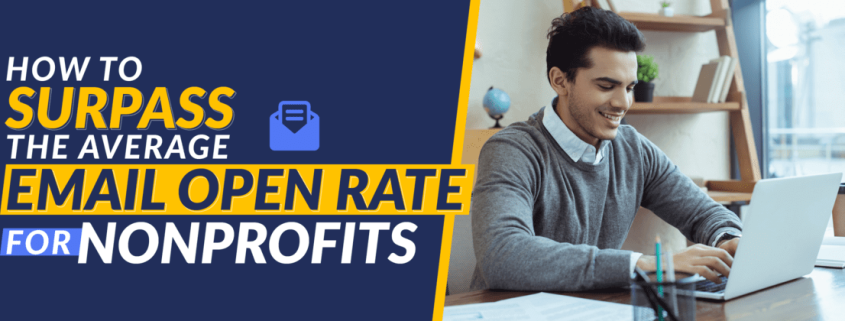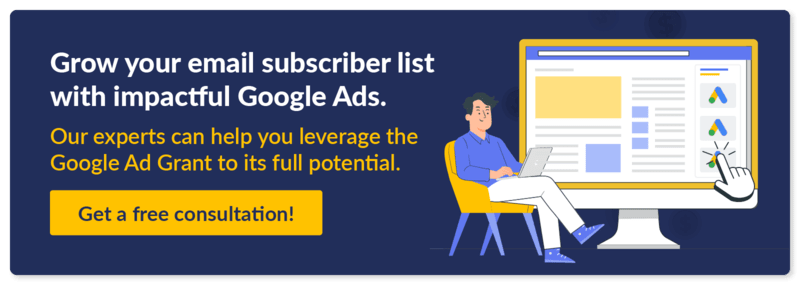How To Surpass the Average Email Open Rate for Nonprofits
Is your nonprofit struggling with low email open rates? Email marketing accounts for 15% of all nonprofit revenue, making it an essential part of your digital marketing strategy. But how does your organization’s performance measure up to the average email open rate for nonprofits?
In this article, we’ll explore industry email benchmarks and share key strategies for surpassing the average email open rate and making a lasting impact on your supporters. Whether you’re looking to craft clickable subject lines or improve your email content, there’s something here for every nonprofit marketer.
Here’s what we’ll cover:
- The Average Email Open Rate For Nonprofits
- Nonprofit Email Frequency
- Return on Fundraising Emails
- Typical Size of Nonprofit Email Subscriber Lists
- How To Fuel Your Email Marketing With Google Ads
Throughout this guide, remember that all of your marketing channels can support each other. While email is great for connecting with supporters, other channels like social media and Google Ads are also essential parts of your digital presence. Let’s dive in so you can start optimizing your email campaigns and drive greater engagement for your cause.
The Average Email Open Rate For Nonprofits
Your email open rate is the percentage of recipients who open your email out of the total number of emails delivered. These are the average nonprofit email open rates for various popular email platforms:
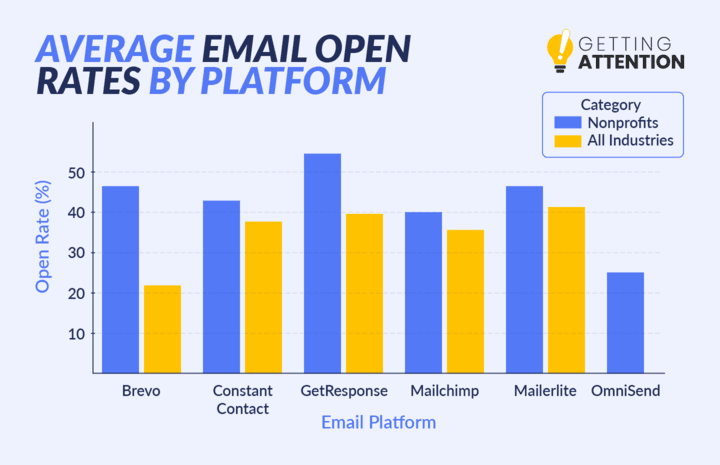
- Brevo – 46.49% for nonprofits, 21.89% for all industries
- Constant Contact – 43.07% for nonprofit membership organizations, 42.8% for nonprofit services, 37.72% for all industries
- GetResponse – 54.54% for nonprofits, 39.64% for all industries
- Mailchimp – 40.04% for nonprofits, 35.63% for all industries
- Mailerlite – 46.49% for nonprofits, 41.31% for all industries
- Omnisend – 25.1% across all industries
Each source uses different samples to generate its marketing statistics. For instance, GetResponse only focused on its platform’s active senders with at least 500 contacts while Constant Contact examined data from over 200 million emails.
One factor that can impact your open rate is your bounce rate. For emails, “bounce rate” means an email failed to deliver. In other contexts, such as search engine ads, bounce rate measures the number of individuals who click on your website but leave almost immediately. The nonprofit average bounce rate for emails is about 6.7%.
Why This Email Marketing Metric Matters
While an open doesn’t guarantee further action, it’s the first step in engaging your audience via email. Nonprofits tend to enjoy slightly higher email open rates than most industries, which can be attributed to several factors.
Email list subscribers are often deeply invested in the causes whose email lists they subscribe to, regardless of whether they’ve donated or volunteered. Charitable organizations also typically project a more authoritative and trustworthy image when compared to businesses, making recipients more likely to read communications.
Knowing the average email open rates helps you benchmark your performance against similar organizations. If your rates are below average, it signals a need for improvement in your email strategy. In contrast, high open rates indicate strong supporter engagement, which is essential for maintaining and growing your donor base.
How To Improve Your Nonprofit Email Open Rate
If your email open rates are lower than expected, experiment with different strategies, such as:
- Create intriguing and relevant subject lines that capture attention and entice recipients to open the email.
- Ensure your subject lines are the right length. If they’re too long, they’ll get cut off in supporters’ inboxes. If they’re too short, they might be too vague to catch supporters’ interest. GetResponse reports that subject lines of 61-70 characters have the highest open rate at 43.38%.
- Use A/B testing to compare how well different subject lines perform.
- Create engaging preheader text to provide additional context or a compelling reason to open the email. Emails with preheader text have an average open rate of 44.67% while those without it only have 39.28%, according to that same GetResponse benchmark report.
- Use a recognizable and trustworthy sender name to make your emails feel personal and credible.
- Experiment with different sending times to determine when your audience is most likely to open emails.
- Conduct an email append to ensure you have accurate email addresses. Email appending involves partnering with a trusted service provider who compares your supporter data to their comprehensive databases to verify your contacts’ current email addresses.
If your supporters aren’t opening your nonprofit’s emails, try these strategies to make your outreach enticing. Whenever you try a new approach, check your email open rate to see if the change drove more people to click and read your messages.
The Average Frequency of Nonprofit Emails
Curious whether you’re emailing your supporters too often (or not enough)? According to the 2023 Nonprofit Tech For Good Report, around 68% of nonprofits use email marketing to reach their supporters. Here’s how frequently these organizations send emails:
- 41% monthly
- 27% quarterly
- 17% twice monthly
- 10% weekly
- 3% twice weekly
- 2% daily
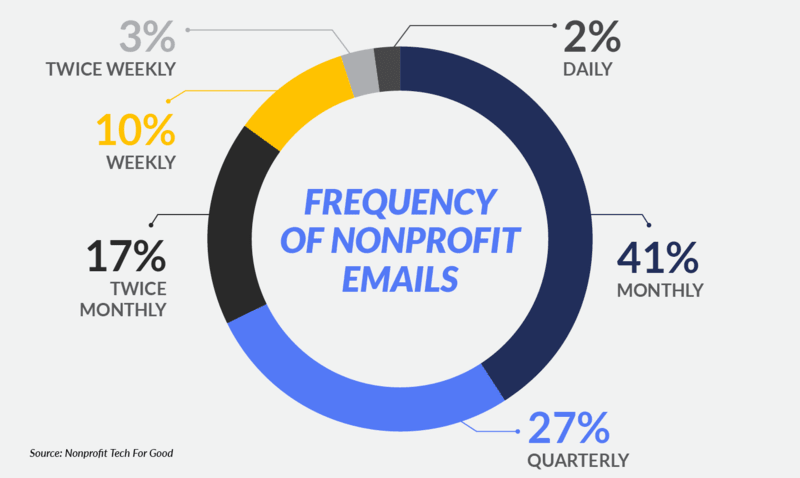
Why This Nonprofit Email Marketing Metric Matters
The frequency of your emails can significantly impact your audience’s engagement levels. Sending messages too frequently can lead to subscriber fatigue, resulting in lower email open rates and higher unsubscribe rates. On the other hand, sending infrequent outreach can cause your audience to forget about your organization, reducing their engagement.
If you’re sending emails less frequently than the industry average, you might be missing opportunities to engage with your supporters. If you decide to send more frequently, it’s important to ensure your content remains valuable, relevant, and varied to avoid overwhelming your audience.
By aligning your email frequency with industry norms, you can better engage your audience, increase donations, and ultimately drive support for your cause.
How To Time Your Emails Effectively
Follow these tips to strategically time your nonprofit’s emails and improve your email open rate:
- Review past email performance data to identify when your audience is most active and likely to open emails.
- Schedule emails based on recipients’ time zones to ensure they receive your emails at optimal times. To simplify this, segment your email list by time zone.
- Conduct A/B testing by sending emails at different times to see which sending time slots result in higher open and click-through rates.
- Avoid sending emails during times when people are likely to be busy. According to Brevo, the best days to send marketing emails are Tuesday and Thursday from 10 a.m. to 3 p.m. However, other sources report different results. The best approach is to pay attention to your nonprofit’s unique audience and email preferences.
- Use email marketing platforms that offer automated scheduling to base your email send times on recipient behavior and engagement history.
While you can use industry benchmarks to find the best time to email supporters, it’s more important to pay attention to when your supporters are active online. Use industry research as your starting point and go from there.
The Average Return on Fundraising Emails
Email marketing and promotional campaigns are powerful tools for fundraising, accounting for approximately 28% of all online nonprofit revenue. For every 1,000 fundraising emails sent, nonprofits raise an average of $90. Other marketing research shows that the average nonprofit raises $5,598.51 per email campaign. These statistics highlight the potential financial impact of a well-crafted email campaign.
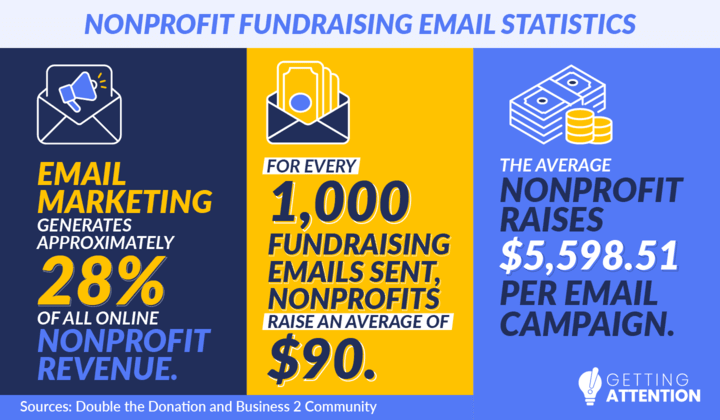
Another important metric to pay attention to is the nonprofit sector’s email click-through rate (CTR), which indicates the percentage of recipients who click on links within your email out of the total number of emails delivered.
Similar to the average email open rate for nonprofits, the average CTR for nonprofits varies across email platforms. For instance, Constant Contact reports a 2.94% click rate for nonprofit membership organizations and 2.34% for nonprofit service organizations. Meanwhile, for nonprofits in general, Mailerlite reports a 3.78% click rate, and Mailchimp reports a 3.27% click rate.
Why These Email Marketing Metrics Matters
An individual who opens your email but takes no action is not a useful return on your email campaign’s investment. By comparing your performance to the entire industry’s results, you can determine whether your messages inspire people to click through to your nonprofit website and take an action like donating or if you should focus your efforts elsewhere. For instance, maybe your supporters prefer using Facebook or Instagram over email, making those channels more important for your nonprofit.
How To Earn More From Fundraising and Product Sale Emails
To maximize the effectiveness of your emails to boost donations and sell your nonprofit’s products and services, experiment with the following strategies:
- Feature clear CTAs that are direct and compelling. Clearly define what you want recipients to do next, whether it’s donating, volunteering, buying your products, or sharing your message.
- Build a trustworthy and recognizable brand with strong graphic design and a consistent tone across emails.
- Leverage marketing grants to alleviate costs. These grants can provide valuable resources for expanding your outreach and enhancing your email campaigns without straining your budget.
- Send thank-you emails to donors, volunteers, sponsors, and other contributors. The next time you send a marketing email, they’ll remember how appreciative your team was, making them more likely to engage with your organization.
- Share impactful stories of how donations have made a difference. In fundraising emails, highlight real-life examples of individuals or communities that have benefited from your supporters’ contributions to create an emotional connection and inspire further giving.
- Promote other forms of giving, like matching gifts, recurring donations, and volunteer grants. That way, they have plenty of options to diversify their relationship with your nonprofit.
Email is one of the best channels for fundraising, so make sure you’re using it to its fullest potential. Show appreciation, try out new strategies, and inspire your supporters with every message to make this channel even more valuable.
The Average Size of Nonprofit Email Subscriber Lists
The average size of nonprofit email subscriber lists varies significantly based on the organization’s size and reach. On average, nonprofit email lists contain around 4,191 contacts. Small nonprofits typically have about 547 subscribers, while large organizations average 6,602, heavily skewing the industry average.
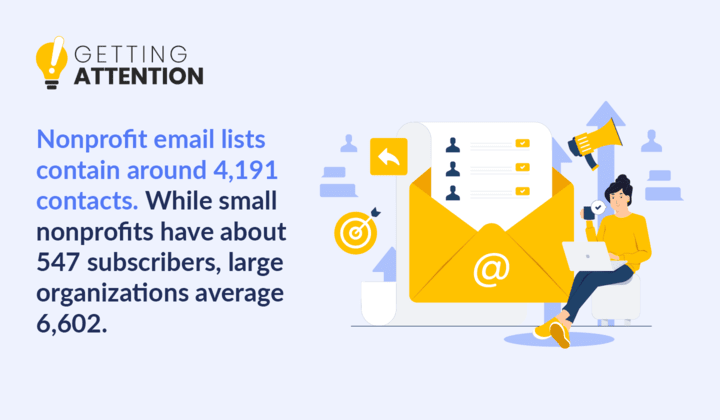
The average unsubscribe rate for nonprofits is also fairly low, coming in at about 0.18%. Keeping your unsubscribe rate low is essential for growing your contacts list. Plus, it indicates that your nonprofit is providing value to its subscribers.
While it might seem that having a larger email list is better, your engagement rate is far more critical. It’s possible to have a large email list of inactive supporters and deactivated email addresses, which provide little value. In contrast, a small but engaged subscriber base is more likely to open emails, click through them, and take action.
Why This Nonprofit Email Marketing Metric Matters
These email marketing benchmarks provide a foundation for measuring your messages’ value. Are you providing engaging content that retains subscribers and drives engagement? Conversely, are you causing people to unsubscribe due to poor content quality or communication frequency? Remember, an engaged audience is much more likely to respond positively to fundraising appeals, leading to higher open rates, click-through rates (CTR), and overall support.
How To Grow Your Email List
Here are several strategies to fill your nonprofit’s email list with engaged supporters:
- Provide diverse content tailored to your audience’s interests. Consider sending different types of content like newsletters, event announcements, impact stories, and educational resources.
- Segment your contact list to send relevant and personalized appeals. For example, send upcoming volunteer opportunities to those who have shown interest in volunteering. This increases engagement and the likelihood of subscribers staying on your list.
- Create a simple email sign-up form that’s easy to find on your website. Highlight the benefits of subscribing and consider using pop-ups or slide-ins to capture attention. If you decide to use pop-ups, remember to disable them on the mobile view of your website.
- Invest in nonprofit ads, such as Google Ads, to promote your email newsletter. Targeted ads can help you attract high-value subscribers. Plus, paid ads are great for driving all sorts of actions for your nonprofit!
Above all, spend time choosing the right channels to promote your newsletter. Remember, you’re aiming for quality over quantity! That way, you won’t fill your subscriber list with disengaged people, inadvertently lowering your nonprofit’s email open rate.
How To Fuel Your Email Marketing With Google Ads
You can use other channels to support your email marketing efforts and grow an active subscriber list that opens your emails.
Google Ads is one of the best channels to support your email marketing. In fact, Google owns over 91% of the search engine market. The search engine behemoth processes about 3.5 billion search queries every day, making Google Ads an incredibly impactful way to connect with new supporters and grow your contact list.
Plus, nonprofits can claim free advertising credits via the Google Ad Grants program! This program provides up to $10,000 a month to eligible nonprofits, helping them pursue goals like increasing email registrations. Check out the benefits in our short overview video:
Sounds too good to pass up, right? Here’s how your nonprofit can promote its email subscriber list via Google Ads:
- Use compelling calls to action. Ensure your ad copy highlights the benefits of subscribing to your email list, such as receiving exclusive updates, special offers, or valuable content.
- Target specific audiences. Use Google Ads’ targeting capabilities to reach audiences likely to be interested in your content and subscribe.
- Offer exclusive content to email subscribers. Promote that you provide valuable content like eBooks or industry reports to email subscribers. Your Google Ads can highlight this content and encourage sign-ups.
- Optimize your Google Ad landing pages. Direct users to landing pages specifically designed for email sign-ups. Ensure the sign-up process is straightforward and user-friendly.
By following these tips, your nonprofit can use Google Ads to enhance its email marketing efforts and grow its subscriber lists with valuable supporters. In no time, you’ll boost your nonprofit email open rates.
If you need help leveraging this channel, reach out to our Google Ad Grants experts. We’ll take the time to understand your mission and marketing goals. Then, we’ll craft compelling ads, monitor your account, and re-apply for the grant if your account is ever deactivated.
Start Improving Your Nonprofit’s Marketing
By focusing on audience engagement and data-driven insights, your nonprofit can build stronger connections with supporters and drive impactful results via email marketing. Remember, the key to success lies in consistent, thoughtful communication and a willingness to adapt and refine your approach based on performance metrics.
Embrace these practices to maximize your email marketing campaigns’ potential and surpass the average nonprofit email open rate.
For other nonprofit marketing advice, check out these educational resources:
- Nonprofit Marketing: A Behind-the-Scenes Guide for Success. Email marketing is just one aspect of a holistic marketing strategy. Read this guide to make sure you’re focusing on the right channels.
- How to Apply for Google Grants: Get Approved in 4 Easy Steps. If you want to advertise on Google for free, read this guide. You’ll be able to determine whether you’re eligible for the Google Ad Grant program and take the necessary steps to apply.
- Free Nonprofit Marketing Tools You Need To Amplify Support. Marketing costs can add up. Explore this list of free tools that’ll help you alleviate costs and connect with supporters.
